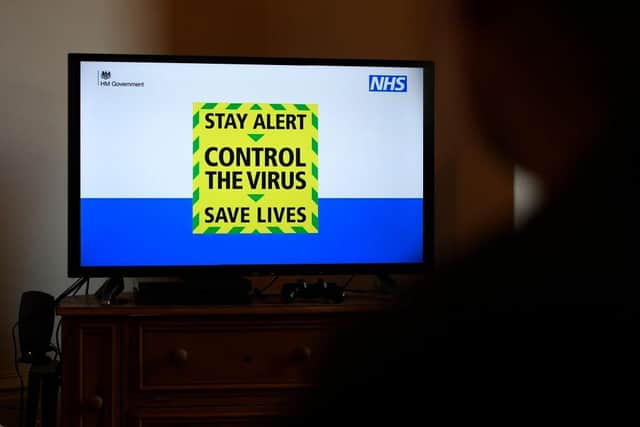Covid Alert System: how UK coronavirus threat level is measured – and when the current level could be lowered
and live on Freeview channel 276
The ‘alert system’ will rank the threat level of coronavirus on a scale of one to five in England, and will be used to inform when lockdown measures can be eased.
The UK government will conduct its new lockdown review on 28 May, with any amendments expected to come into force a few days later, from 1 June.
Advertisement
Hide AdAdvertisement
Hide AdThe Prime Minister will lead the Downing Street press conference on Thursday (28 May), which comes after the latest SAGE meeting at which lockdown measures were reviewed, during which he is expected to lower the Covid alert level.


What is the Covid Alert System?
The Covid Alert System will be determined mainly by the reinfection rate and the number of coronavirus cases, and will be run by a new Joint Biosecurity Centre.
The new five-point alert system will rank the threat level of the virus on a scale of one (green) to five (five), with social distancing measures becoming tougher the higher the threat level is.
The threat level will be adjusted accordingly based on medical and scientific data, with experts analysing data from hospitals and a new smartphone tracking app to inform an accurate picture of infection rates.
What do the five alert levels mean?
Advertisement
Hide AdAdvertisement
Hide AdThese are the five alert levels that will be used to inform the easing, or tightening, of lockdown restrictions:
Level five - Critical. This level would require a strict lockdown and means the virus is spreading fast, and could overwhelm the NHS
Level four - Severe. This is the level the UK is currently at and means the NHS is stretched but is coping
Level three - Substantial. This means the virus is in general circulation and the NHS is operating at extra capacity. Some restrictions will need to remain in place, but it will be safe to relax some measures
Advertisement
Hide AdAdvertisement
Hide AdLevel two - Moderate. This means there is a low level of virus transmission and the NHS is operating normally. Schools and businesses should be able to open, subject to social distancing measures
Level one - Low. This means the virus is no longer present in the UK. No behavioural restrictions will be needed, and public and private sectors will be able to operate normally
What is the current threat level in the UK?
The UK is currently at alert level four, just below the “most critical” threat.
However, Mr Johnson said in his nationwide address on Sunday (10 May) that the UK is now moving towards level three, and the further down the alert system the country goes, the more lockdown measures could be eased.
Advertisement
Hide AdAdvertisement
Hide AdThe Prime Minister is expected to announce a lowering of the current alert level to three in his daily press briefing on Thursday (28 May).
Mr Johnson said: “Covid alert level will be determined primarily by R and the number of coronavirus cases.
"And in turn that Covid alert level will tell us how tough we have to be in our social-distancing measures - the lower the level, the fewer the measures. The higher the level, the tougher and stricter we will have to be.
"There will be five alert levels.
“Level one means the disease is no longer present in the UK and level five is the most critical - the kind of situation we could have had if the NHS had been overwhelmed.
"Over the period of the lockdown, we have been in level four, and it is thanks to your sacrifice we are now in a position to begin to move in steps to level three."
